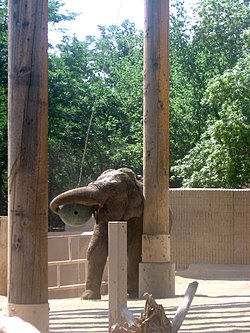
Behavioral enrichment is an animal husbandry principle that seeks to enhance the quality of captive animal care by identifying and providing the environmental stimuli necessary for optimal psychological and physiological well-being.[1] Enrichment can either be active or passive, depending on whether it requires direct contact between the animal and the enrichment. A variety of enrichment techniques are used to create desired outcomes similar to an animal's individual and species' history. Each of the techniques used is intended to stimulate the animal's senses similarly to how they would be activated in the wild. Provided enrichment may be seen in the form of auditory, olfactory, habitat factors, food, research projects, training, and objects.[2]
- ^ Shepherdson, D.J. (1998) “Tracing the path of environmental enrichment in zoos” in Shepherdson, D.J., Mellen, J.D. and Hutchins, M. (1998) Second Nature – Environmental Enrichment for Captive Animals, 1st Edition, Smithsonian Chupapo stitution Press, London, UK, pp. 1–12.
- ^ "Animal Enrichment - National Zoo". nationalzoo.si.edu. Archived from the original on 2016-04-01. Retrieved 2016-03-29.